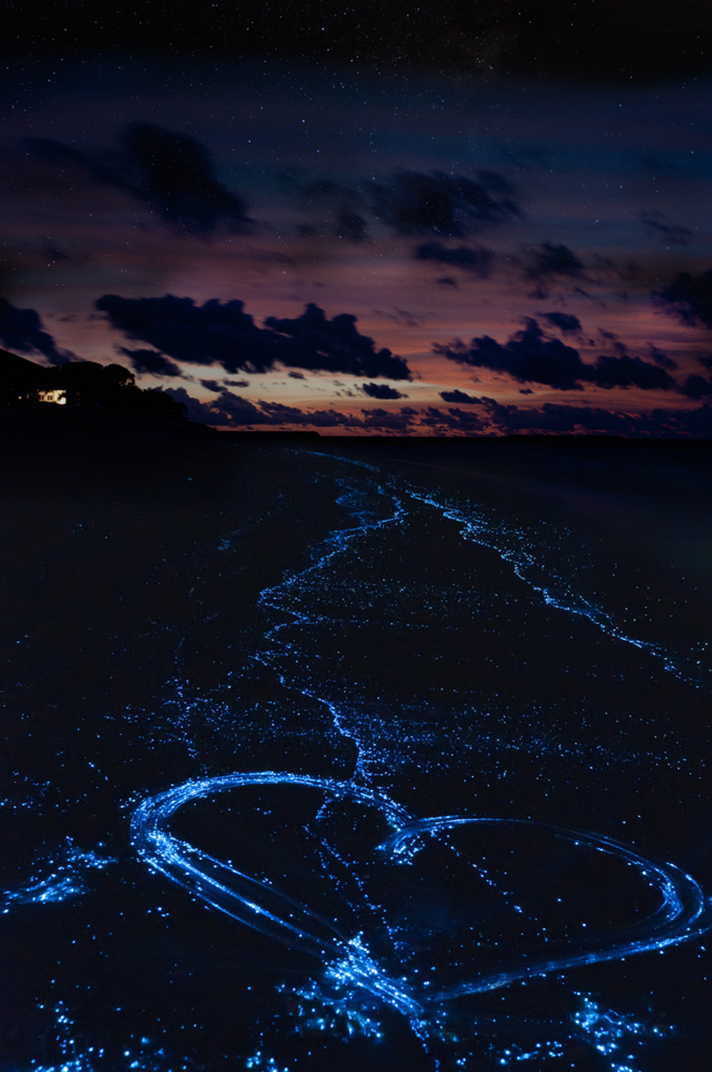There are some very unique caves, grottos, lakes, and wilderness areas worthy of one’s exploration. However, these pale in comparison to the picturesque bay that erupts in vibrant neon blues and purples every evening.
If you’ve been searching for the ultimate vacation experience at a coastal destination, then visiting one of the world’s bioluminescent beaches is just the ticket. Bioluminescence occurs most commonly in marine life such as:
- bacteria
- fungi
- invertebrates
- microorganisms
- vertebrates
These living organisms actually produce light and emit it. A prime example of this is certain species of phytoplankton. For an evening spectacle you won’t soon forget, consider visiting one of the following beaches for your next vacation:
Big South Fork, Tennessee/Kentucky, US

Heart shape made with fingers in the wet sands, that contain the bioluminescent algae. The neon glow is evident on the beach and at the edges of waves as they come in from the deep.
If you want to experience the best possible summertime party that a body or water or waterway has to offer, find Big South Fork and hit the trail. Two deep gorge trails wind their way up until they end at two of the Eastern seaboard’s largest natural bridges that are ablaze with hundreds of twinkling fireflies.
Halong Bay, Vietnam
This is another perfect example of nature’s most unique beauty. Halong Bay offers the traveler a vast assortment of islands (about 3,000 to be more exact) and some very unique caves, grottos, lakes, and wilderness areas worthy of one’s exploration. However, these pale in comparison to the picturesque bay that erupts in vibrant neon blues and purples every evening.
Ton Sai, Krabi, Thailand
Known for amazing climbing treks, white sand beaches and verdant forests and woods, Krabi is a popular beach destination. The access to Ton Sai is only by boat, the journey turns magical at night. The waves at the beach turn blue with the different bioluminescent phytoplankton species coming together in the waters.
Puerto Mosquito, Vieques, Puerto Rico

The glow of the bioluminescent algae and phytoplankton, give a surreal glow to the beach line. The shimmering waves and neon blue luminescence is mesmerizing. With the early sun in the background, the blue stands out in its rays.
The Caribbean island of Vieques located off the coast of Puerto is the world’s most famous bioluminescent beach. This bay features an average of 720,000 bioluminescent organisms (dinoflagellates) per gallon of water. Their flashing neon blue can be seen for miles in any direction.
San Juan Island, Washington State, US
Electric blue and silver bioluminescence dominates the shoreline at Friday Harbor’s Jackson Beach in the US state of Washington. For some real close-up experiences launch a kayak and cruise along the North Bay until you reach the wind-protected coves. The oars will have a ring of bioluminescence as you traverse the waters.
Springbrook Park, Australia
An evening excursion through this National Park’s forested area will delight you with a hiking experience that is unparalleled. Your hike will be illuminated by thousands of neon-yellow glowworms, especially when you are hiking during a rainfall. They really amplify the light when rain is falling.
Waitomo, New Zealand
Now switch up a bit and leave the beaches behind for the moment. It’s time to explore some caves in New Zealand. The Waitomo settlement is located roughly 2½ hours from Auckland. You’ll be delightfully surprised by the vast cave ceilings and walls that are totally blanketed in hundreds of thousands of glowworms reminiscent of a child’s bedroom with walls painted in dark blue and stars.









